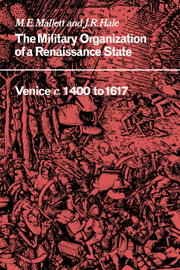Book contents
- Frontmatter
- Contents
- List of illustrations
- Acknowledgements
- References and abbreviations
- Map 1 The Terraferma in the fifteenth and sixteenth centuries
- Map 2 The empire da Mar
- PART I c. 1400 to 1508
- PART II 1509–1617
- Conclusion: the European context 1525–1617
- Appendix Infantry wages in the sixteenth century
- Select bibliography
- Index
Conclusion: the European context 1525–1617
Published online by Cambridge University Press: 22 October 2009
- Frontmatter
- Contents
- List of illustrations
- Acknowledgements
- References and abbreviations
- Map 1 The Terraferma in the fifteenth and sixteenth centuries
- Map 2 The empire da Mar
- PART I c. 1400 to 1508
- PART II 1509–1617
- Conclusion: the European context 1525–1617
- Appendix Infantry wages in the sixteenth century
- Select bibliography
- Index
Summary
The composition of Venice's armed forces was already traditional by 1530: a permanent nucleus, supplemented in crisis or war by mercenaries and native volunteers, and supported by a more or less trained militia. This basic formula did not change, but neither did it grow out of date. It was the formula employed by all the settled, centralized western states of comparable or greater size.
All had a standing army of royal guards and troops in frontier garrisons varying in numbers from England's average of 2000 to the 12,000 of pre-Civil War France and the 23,500 maintained at the century's end by Spain in Italy, North Africa, the Azores and Canaries and Portugal as well as in Spain itself. These numbers, thanks to varying leave systems (the French men-at-arms, for instance, were, like those of Venice, on leave for half the year in peacetime) and faulty book-keeping, are uncertain. As with Venice, a ‘standing army’ could not be assumed to be well trained, up to effective strength, of uniform national origin or characterized by a high morale based on regular pay and promotion prospects. The term represents little more than the size of a force on which expenditure was accepted as ‘ordinary’. Something more like the skill and sentiment associated with the later connotations of the phrase only occurred when forces were kept in being during particularly prolonged campaigns, as on the Hungarian–Croatian border where the forces of Ferdinand I and Maximilian II fought the Turks year after year or, most spectacularly in terms of the numbers employed, during Spain's wars in the Netherlands.
- Type
- Chapter
- Information
- The Military Organisation of a Renaissance StateVenice c.1400 to 1617, pp. 485 - 493Publisher: Cambridge University PressPrint publication year: 1984



